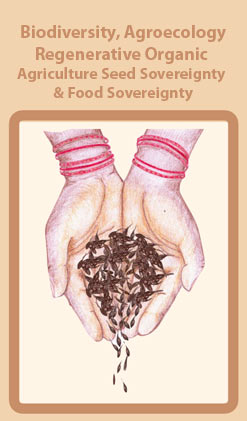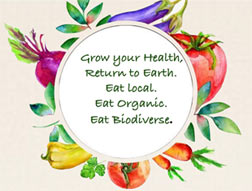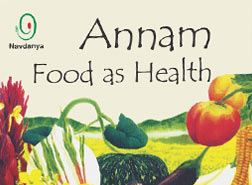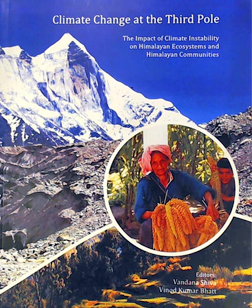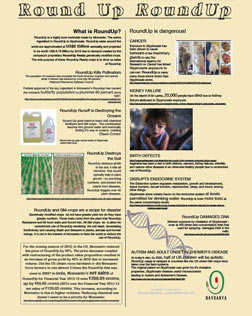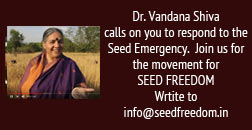4000 years ago the ancient Vedas of India had guided us
“Upon this handful of soil our survival depends. Care for it, and it will grow our food, our fuel, our shelter and surround us with beauty. Abuse it, and the soil will collapse and die, taking humanity with it.”
In living soil lies the prosperity and security of civilization. In the death of soil is the death of civilization.
Our future is inseperable.from future of the Earth . It is no accident that the word human has its roots in humous,soil in Latin, and Adam the first human in Abrahamanic traditions is derived from Adamus, soil in Hebrew.
We forget that we are Soil.
Food security is Soil Security. Chemical agriculture treats soil as inert and an empty container for chemical fertilisers. The new paradigm recognizes the soil as living, in which billions of soil organisms create soil fertility. Their well being is vital to human well being. Looked at from this point of view, the immediate aim of fertilization is not to increase yields and fertilize plants, but to build up soil fertility. This is exactly what Rudolf Steiner meant when he coined the famous phrase: “Fertilization means nurturing a living soil”.
We have been mistakenly been led to believe that soil fertility comes from factories that earlier made explosives, now make synthetic fertilisers . As Howard points out in the Agricultural testament,
“The feature of the manuring of the west is the use of artificial manures. The factories engaged during the Great War in the fixation of nitrogen for the manufacture of explosives had to find other markets,the use of nitrogenous fertilisers in agriculture increased, until today, the majority of farmers and market gardeners base their manorial programme on the cheapest forms of nitrogen(N),phosphrous (P), and potassium(K) on the market. What may be conveniently described as the NPK mentality dominates farming alike,in the experimental stations and in the countryside. Vested intersts entrenched in time of national emergency, have gained a strangehold”
With their roots in war, synthetic fertilisers continue the war against the living soil. Mycorrhizae and earthworms do not survive the application of chemical fertilisers. Chemically fertilized soils loose their structure and their water holding capacity. They need more irrigation and are prone to erosion.
About two thirds of the nitrogen fertilizer applied is not taken up by the plant. It contaminates ground water with nitrate pollution.It contaminates surface waters, leading to eutrophication (overfertilisation) of rivers and lakes,and dead zones in coastal waters.
Large parts of nitrogen fertilizer escapes into the air as nitrous oxide which has an atmospheric life of 166 years and is 300 times more damaging to the atmosphere than CO2.
The Soil is a living system, with billions of soil organism weaving an intricate soil food web to create, maintain ,and renew soil fertility, on which all food production rests. As Howard stated “the birthright of every crop is health”
And “Health in Soil, Plant, animal and man is one great subject”pg 11 (Soil and Health)
Healthy and fertile soils make healthy plants which make healthy people.
Sir Albert Howard defined fertile soil as
“a soil teeming with healthy life in the shape of abundant microflora, will bear healthy plants, and these ,when consumed by animals and man, will confer health on animals and man. But an infertile soil,that is,one lacking sufficient microbial,fungus,and other life,will pass on some form of deficiency to the plant, and such plant ,in turn,will pass on some form of deficiency to animals and man.(Louise Howard Sir Albert Howard in India , London, Faber and Faber 1953 p xv)
Howard had warned us nearly a century ago
“We must look at our present civilization as a whole and realize once and for all the great principle that the actvities of homosapiens, which have created the machine age in which we are now living, are based on a very insecure basis-the surplus food made available by the plunder of stores of soil fertility which are not ours but the property of generations to come .(pg 64 Soil and Health)
“No one generation has the right to exhaust the soil from which humanity must draw its sustenance”( pg 13 Soil and Health)
Ecological agriculture is based on recycling organic matter , and hence recycling nutrients. Organic matter is broken down by soil organisms to form humus.
Humus is the Latin word for Soil or Earth.
Soils rich in organic matter and humus are rich in fungi like mycorrhizae, which infect plant roots and mobilize nutrients and moisture for plants. Humus is like a sponge, and can hold up to 90% of its weight in water. Soils without humus have no mycorrhizae. This makes them more vulnerable to draught, nutrient deficiency and soil erosion. Bacteria that live on humus provide a glue to bind soil particles and create compound soil particles or soil aggregates. In the absence of soil microorganisms , soil does not bind, it becomes dust, and is easily blown away by wind, and washed away by water.
Ecological agriculture is based on the law of return, of giving back nutrients to the soil, not just taking nutrition out of it. Taking without giving is a robbery of the soil, a banditry…”a particularly mean form of banditry, because it involves the robbing of future generations which are not here to defend themselves”
).
In the ancient Indian text, the Atharva Veda, there is a prayer to the Earth, Prithvi Sukta which says
Whatever,I dig of you,O Earth,
May that grow quickly upon you,
O pure One,may my thrust never pierce thy
Vital points, Thy Heart
Living seeds and living soils are the foundation of living and lasting societies.
Not only do living Soils provide food, nutrition and health security , they also provide us climate security.
In my book Soil, not Oil, I had assessed that more than 40% of greenhouse gases that lead to climate change are contributed by industrial, globalized agriculture. These Chemical Monocultures are also more prone to failure due to extended droughts, intense floods and untimely rains.
On the other hand, organic farming reduces emissions, and also makes agriculture more resilient to climate change. Because organic farming is based on returning organic matter to the soil, it is the most effective means to remove excess carbon in the air, where it does not belong, and putting it in the soil, where it belongs. Navdanya’s research has shown that organic farming has increased carbon absorption by 55%. International studies show that with 2 tons per Ha of Soil Organic carbon, we can remove 10 Giga tons of carbon dioxide from the atmosphere, which can reduce the atmospheric pollution to 350ppm.
In addition, organic matter in the soil also increases water-holding capacity of the soil, reducing the impact of floods and droughts. A 1% increase in Soil Organic Matter can increase soil water holding capacity by 100,000 liters per ha. 5% can increase it to 800,000litres. This is our insurance against climate change, both when there is drought and too little rain, and when there are floods and excess rain. On the other hand, cement and concrete increases runoff of water, aggravating floods and drought.
In Living Soil lies the solution to climate change, both through mitigation and adaptation.
Tagore invites us to return to the soil to make peace with the earth.
Let us all return to the soil
That lays the corners of its garments
And waits for us.
Life rears itself from her breast,
Flowers bloom from her smiles
Her call is the sweetest music;
Her lap stretches from one corner to the other,
She controls the strings of life.
Her warbling waters bring
The murmur of life from all eternity.
© 2016 Navdanya. All rights reserved. Design Inn Info Solution

